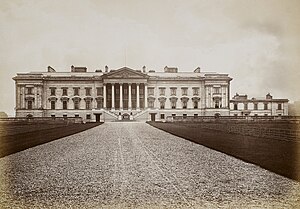| Hamilton Palace | |
|---|---|
 Hamilton Palace in 1870. | |
 | |
| General information | |
| Status | Demolished |
| Architectural style | Baroque, Neoclassical |
| Town or city | Hamilton, South Lanarkshire |
| Country | Scotland |
| Construction started | 14th century |
| Completed | 1701, with additions 1824-1832 |
| Demolished | 1921-1932 |
| Design and construction | |
| Architect(s) | James Smith William Adam David Hamilton |

Hamilton Palace was a country house in Hamilton, South Lanarkshire, Scotland. It was the seat of the Dukes of Hamilton and is widely acknowledged as having been one of the grandest houses in the British Isles.[1] The palace dated from the 14th century, was rebuilt in the Baroque style between 1684 and 1701 and was subsequently much enlarged in the Neoclassical style between 1824 and 1832.[2]
The palace was situated at the centre of the extensive Low Parks (now Strathclyde Country Park), with the Great Avenue, a broad, north–south tree-lined avenue over three miles (five kilometres) in length, as its axis. The Low Parks also contained the Hamilton Mausoleum designed by David Hamilton and the 11th-century Netherton Cross. South of the Avon Water, the High Parks (now Chatelherault Country Park) contained the Deer Park and the Chatelherault Hunting Lodge designed by William Adam.[2] The palace housed two libraries and a renowned collection of fine and decorative art which were dispersed in two huge sales in 1882 and 1919.
Hamilton Palace was demolished between 1921 and 1932 after coal works beneath the house were discovered to threaten its structural integrity.[3][4][5]
- ^ Hamilton's royal past, South Lanarkshire Council
- ^ a b "the palace and parks: Hamilton Palace: a virtual reconstruction". Retrieved 19 March 2021.
- ^ Airdrie and Coatbridge Advertiser; Saturday 14 June 1919
- ^ The Scotsman; Tuesday 11 October 1921
- ^ Aberdeen Press and Journal; Tuesday 15 November 1921